当前位置:网站首页>MPLS experiment
MPLS experiment
2022-07-06 21:44:00 【Half cold and half hot】
MPLS: Multiprotocol label switching
multi-protocol : Can be based on a variety of different 3 Layer protocol to generate 2.5 Label information of layer ;
Packet exchange — The packet is a network layer PDU, Therefore, packet switching is based on IP Address for data forwarding ; Is the routing behavior of the router ;
Original packet exchange : After the packet enters the router , The router needs to query the local routing table (RIB- Routing information database ), Based on the next jump or target ip Check the local ARP surface , To forward data ;
Fast packet switching : One route, multiple exchanges ; The first packet in each data stream will be forwarded based on the original packet exchange rules ; Generate cache list in the process , Record the whole communication process , The remaining packets of the data traffic can only query the cache records ;
Express packet exchange : No routing required , Direct exchange ; CEF-cisco Express exchange , by cisco Private technology ; Not cisco Manufacturer's equipment exists and cef The forwarding mechanism is the same technology ;
Routing table 、ARP – Convert to FIB( Forwarding information database ) surface Only query during traffic forwarding FIB Just watch ;
FIB Characteristics : During the conversion of router tables , Storage Recursive query results ; At the same time, bind the newly encapsulated layer-2 address ;
IP fast0/0 172.16.20.115(7)
( Recursive out interface ) 0 packets, 0 bytes
epoch 0
sourced in sev-epoch 357
Encap length 14
701CE7662A9768EFBD1D24C50800 New two-layer package
The goal is MAC Source MAC Type number
Label switching : The packet enters the MPLS After , In the fourth 2 Layer and the 3 Press in the label number in the middle of the layer ; Make the router in the domain forward the packet , be based on 2.5 The tag number of the layer only needs to query the local one LFIB surface ( Tag forwarding information database )
Initially, when packet switching only supports original switching , The meaning of tags is faster queries ; But as packet switching accelerates , Using label switching loses the advantage of fast table lookup ;
The present MPLS Meaning of existence :
1、 solve BGP The routing black hole of 2、MPLS VPN 3、MPLS TE Flow engineering
in addition : With the acceleration of packet switching , Make today's MPLS Technology is also beginning to be based on FIB Table work ; To improve the MPLS Work efficiency ;
One 、 working process
Control level : Routing protocols work , Generate RIB, The direction of flow is the control flow ;
Data level : The device accesses the destination based on the routing table , Generate data traffic ; In the opposite direction of the control level ;
Control level :
1) In the absence of MPLS The control level only generates RIB( Routing table ) and FIB( Forwarding information database );FIB Is based on RIB Generate ;
2)MPLS The agreement will start TDP(cisco private ) or LDP( public ), Direct connect device A neighbor relationship will be established between ;
LDP-- be based on UDP and TCP Of 646 Port operation ; First use udp Send multicast hello The bag found a neighbor , Get neighbors ip Address , Then establish... With the direct neighbor TCP Conversation ; After the neighbor relationship is established ; For the stability of neighborhood relations , Generally, the loopback address of the device is used to establish tcp conversation ; It is recommended to set the loopback address to mpls Agreed route-id, The id The value will be carried in the multicast transceiver hello In the message , After that, it will automatically tcp Session creation ;
summary :MPLS The protocol needs to be used between direct neighbors router-id Address to carry out TCP Conversation ; Therefore, the prerequisite is ,route-id Must be for real use of the equipment ip Address , Suggested loopback address — Stable ; Multicast hello Packets are sent and received on a directly connected physical interface , To get the opposite end router-id, Nature also requires router-id The route between values can reach ;
So normal is building LDP Between neighbors , The routing protocol has converged ,RIB and FIB Table has been generated ;
3)MPLS After building a neighborhood , Generate Neighborhood watch ;LDP The protocol is then based on local FIB The route entries learned in the table generate tag numbers ;cisco The default device is based on FIB All learned routing entries in the table generate tag numbers , Huawei devices are only based on by default FIB In the table 32 Bit masked host routes generate tag numbers ; The reason is that normal 32 Bit host routing is ospf Learn the loopback interface , In normal engineering, there are only BGP and MPLS VPN Based on loopback communication , Use tags to forward ; Other ordinary traffic is based on express packet exchange ; take the reverse into consideration cisco Start up mpls in the future , All traffic will be forwarded based on tags , Reduces forwarding efficiency ( The premise is the default )
4) After the tag number is generated , Will be stored locally LIB surface - Label information database ;LIB The table will be shared among neighbors ;
LIB Load the label numbers distributed by local and neighbors for each route in the table ;
5) function MPLS Agreed devices , take LIB and FIB Combine , Map the relationship between the tag number and the best path to generate become LFIB surface ( Tag forwarding information database )
notes : Control level generated tables
RIB—》FIB---》LIB---》LFIB The first two tables are generated after the routing protocol works , The last two tables are MPLS Of LDP Protocol generation ;
Data level :
- No, MPLS agreement , be based on FIB The table can be forwarded normally
- Noun :MPLS domain – MPLS Working radius of
edge LSR(PE)-- Border label switching router Work mpls The edge of the field , Connect extraterritorial devices
LSR (P) -- Label switching router Overall work MPLS Intra domain
3. When the flow enters the first pe Equipment time , Before there is no express exchange , The router is based on the target IP Address query local RIB;
After that, we'll have to LIB The corresponding in the table can determine whether the flow should be pressed into the label , A query that requires two tables ;
When there is express exchange , The flow enters the first pe when , Direct inquiry FIB surface , Associated tag number in the table , It will be directly determined whether to press the label ;
Flow to P Router , If there is a tag in the received traffic, it is based on LFIB Table forwarding , If there is no label, it is based on FIB Just watch ;
The flow leaves the last boundary MPLS The label will pop up ;
Flow with tag number , When entering the router , Enter the number that the label table should assign to the local router , The label is local downstream ( Next jump ) Tag number assigned to the device ; The upstream and downstream concepts are calibrated based on the data level ;
- Tag number
The label is pressed into 2 Layer and 3 Between layers , be called 2.5 layer

The format of the label ---32 position ,4 Bytes

front 20 Bit is tag number ,2^20 A tag number ; among 1-15 No. reserved , As a special number ;
The first 21-23 position exp,3 position 8 Number , For priority , be used for QOS Strategy use ;
The first 24 Bit is the bottom of the stack , This bit is 1 Identify the label as the last label ;MPLS It can be encapsulated in one packet at most 3 Layer labels ;
ordinary MPLS A layer of labels MPLS VPN Two layers of MPLS TE 3 layer
TTL Time to live When the label is pressed in for the first time , The... In the current packet 3 layer TTL Copy to label ; Then query the tag once TTL Minus one , When the tag pops up on the last hop device 2.5 Layer of TTL Copied to the 3 In the layer header ;
- MPLS The last jump – Penultimate jump Default execution
The border LSR Local Direct connection network segment Pass to MPLS After the neighbors in the domain ,LDP The assigned tag number is 3, Tell the penultimate hop device its identity ; Cause the penultimate hop device to query LFIB After the table , On the premise that the forwarding path is known Pop up labels in advance , So that the last hop router only needs to query FIB surface ; Otherwise, the last hop router is querying LFIB After the table , The pop-up tag also needs to query FIB;
- MPLS Configuration of
- IP Can be up to --- Using routing protocol, the whole network can reach
- To configure MPLS – LDP
[r2]mpls lsr-id 2.2.2.2 Must be defined first mpls Of router-id, for The authenticity of the local device ip Address , And neighbors can reach , because
This address will be used to establish TCP conversation , A loopback address is recommended
[r2]mpls And open mpls agreement
[r2-mpls]mpls ldp Reactivate LDP agreement
[r2-mpls-ldp]q
After that, you need to open the protocol on the interface through which all tags pass
[r2]interface GigabitEthernet 0/0/1
[r2-GigabitEthernet0/0/1]mpls First open MPLS
[r2-GigabitEthernet0/0/1]mpls ldp Reactivate LDP agreement
When the boot configuration is complete , Use between neighbors UDP Message multicast sending and receiving hello package ; Then based on hello In bag router-id address TCP The establishment of conversation ;
[r3]display tcp status
TCPCB Tid/Soid Local Add:port Foreign Add:port VPNID State
b4cf3d64 167/6 3.3.3.3:646 4.4.4.4:50858 0 Established
b4cf3adc 167/3 3.3.3.3:50806 2.2.2.2:646 0 Established
When tcp After the session is established , Neighbors are based on TCP The conversation then establishes a neighbor relationship , Generate Neighborhood watch :
[r3]display mpls ldp peer
And then based on local FIB surface , Default Huawei only for 32 position Generate tag number for host routing ; Store in LIB In the table , Then neighbors share LIB surface ;
[r3]display fib see FIB surface
[r4]display mpls ldp lsp see LIB surface , Load the label number assigned by the local and neighbor for each route
Finally, the router will LIB and FIB aggregate , Generate label forwarding rules for the best path —LFIB
[r4]display mpls lsp see LFIB surface
notes : By default, Huawei is only for 32 Bit host routing assignment label
[r3]mpls
[r3-mpls]lsp-trigger all Turn on the function , Will target fib Label numbers are assigned to all routes in the table
[r2]tracert -v -a 2.2.2.2 56.1.1.2
- Use mpls solve BGP The routing black hole of
MPLS The agreement will not be passed BGP The routing entries of protocol learning are assigned tag numbers ;
But visiting these BGP When routing the target network segment , When the traffic is pushed in, it reaches these network segments BGP Tag number of the next hop device address ;
example :R2 from BGP neighbor 5.5.5.5 Learning to 6.6.6.0 Route of network segment ;R2 During a visit to 6.6.6.0 when , Will be pushed in the packet to arrive 5.5.5.5ip Tag number of the address , To cross the middle without running BGP Agreed devices ; Break the routing black hole ;
notes : Huawei equipment is not... By default BGP The protocol implements the next hop label mechanism ,cisco Default execution ;
Huawei equipment needs to be turned on route recursive-lookup tunnel The route is recursively searched based on the tunnel
- MPLS VPN
- CE Pass private route to PE End
- PE The end receives different CE When sending the same network segment route , Use RD Value to distinguish --- Format X:X 32 position
- PE The end will be attached with RD The private route of cannot be directly loaded into the local public route table , It needs to be placed in the corresponding VRF( Virtual routing forwarding ) In space ; Then pay RT value , Used to pass to the opposite end PE equipment , Peer discrimination information ;
VPNV4 route = Ordinary IPV4 route +RD+RT
- VPNV4 Routing needs MP-BGP To deliver ; The opposite end is based on RT value , Load the route to the corresponding VRF In space , Then share it with the corresponding CE;
- After the control level work is completed , The data level needs to be based on MPLS Come to work , Because the data layer cannot carry RD/RT value ;
so mpls Two layers of labels will be pressed into the packet , The outer label is used to pass through intermediate equipment , break BGP Routing black holes ;
The inner label is used to correspond to VRF Space ;
To configure :
- ISP part
- IGP route
- MPLS Domain
- To configure MPLS VPN
[r2]ip vpn-instance a Create a a Of vrf Space
[r2-vpn-instance-a]ipv4-family Get into IPV4 In configuration mode
[r2-vpn-instance-a-af-ipv4]route-distinguisher 1:1 RD value
[r2-vpn-instance-a-af-ipv4]vpn-target 1:1 RT value Must be end-to-end PE End consistent
[r2]interface GigabitEthernet 0/0/0 Go to the link CE The interface of the end
[r2-GigabitEthernet0/0/0]ip binding vpn-instance a Related to vrf Space
[r2-GigabitEthernet0/0/0]ip address 192.168.2.2 24 Configuration private ip Address
notes : In relation to vrf Interface cannot be configured before space ip, Otherwise, the direct route of the address will enter the public route table ;
[r2]display ip routing-table vpn-instance a View the private routing table in the space
[r2]ping -vpn-instance a 192.168.2.1 The normal test will query the records in the public routing table ; This command is based on VRF Space
a Perform routing query
- PE And PE To establish MP-BPG Neighborhood
[r2]bgp 2
[r2-bgp]router-id 2.2.2.2
Establish a normal connection with the opposite end first BGP Neighborhood , It can be used to deliver normal public network routing
[r2-bgp]pe 4.4.4.4 as-number 2
[r2-bgp]pe 4.4.4.4 connect-interface LoopBack 0
[r2-bgp]pe 4.4.4.4 next-hop-local
At the same time, it needs to be in IPV4 In the family model , Establish a... With the opposite end VPNV4 The relationship between , Used to convey VPNV4 route
[r2-bgp]ipv4-family vpnv4
[r2-bgp-af-vpnv4]peer 4.4.4.4 enable
[r2-bgp]display bgp vpnv4 all peer see mp-bgp Neighborhood
- CE End and PE End to end interactive routing
static state
CE You can write a static route directly at the end ;
PE The end editor writes VRF Static routing in space
[r2]ip route-static vpn-instance a 192.168.1.0 24 192.168.2.1
Will local vrf Static and direct routes in the space are republished to BGP The protocol is passed to the peer PE
[r2]bgp 2
[r2-bgp]ipv4 vpn-instance a
[r2-bgp-a]import-route direct
[r2-bgp-a]import-route static
<r4>display bgp vpnv4 vpn-instance a routing-table see mp-bpg Of BGP surface
OSPF
CE The terminal starts normally OSPF that will do
PE End , start-up VPNV4 A dedicated ospf agreement
[r4]ospf 2 vpn-instance a
[r4-ospf-2]area 0
[r4-ospf-2-area-0.0.0.0]network 192.168.3.1 0.0.0.0
Then use two-way republishing , Realize routing sharing
[r4]bgp 2
[r4-bgp]ipv4-family vpn-instance a
[r4-bgp-a]import-route ospf 2
[r4]ospf 2 vpn-instance a
[r4-ospf-2]import-route bgp
[r4]display mpls lsp vpn-instance a Check the inner label number of the double-layer mark
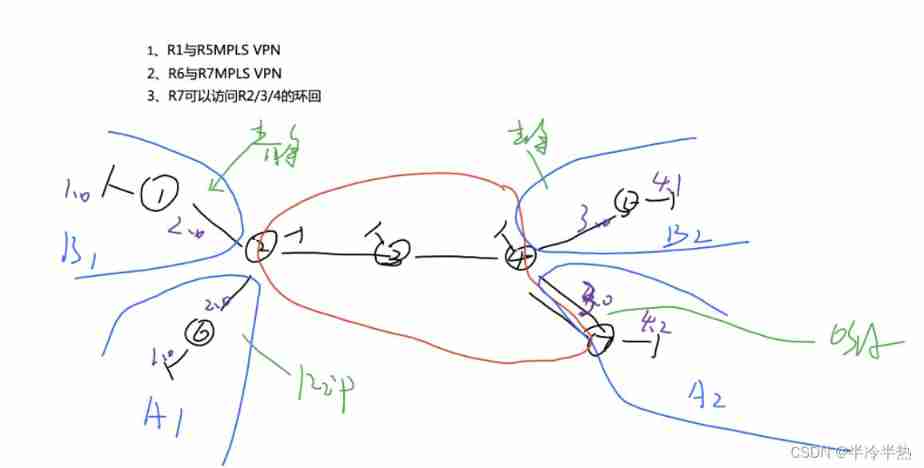
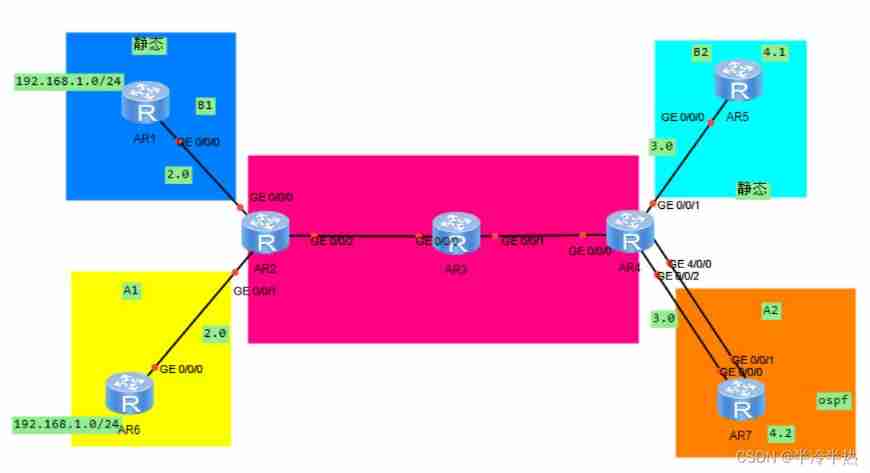
1. Configuration of public network IP Address
[r2]int g 0/0/2
[r2-GigabitEthernet0/0/2]ip add 23.1.1.1 24
[r2-GigabitEthernet0/0/2]q
[r2]int lo 0
[r2-LoopBack0]ip add 2.2.2.2 24
[r2]ospf 1 router-id 2.2.2.2
[r2-ospf-1]area 0
[r2-ospf-1-area-0.0.0.0]network 2.2.2.2 0.0.0.0
[r2-ospf-1-area-0.0.0.0]network 23.1.1.1 0.0.0.0
[r3]int g 0/0/0
[r3-GigabitEthernet0/0/0]ip add 23.1.1.2 24
[r3-GigabitEthernet0/0/0]int g 0/0/1
[r3-GigabitEthernet0/0/1]ip add 34.1.1.1 24
[r3-LoopBack0]ip add 3.3.3.3 24
[r3-LoopBack0]q
[r3]ospf 1 router-id 3.3.3.3
[r3-ospf-1]area 0
[r3-ospf-1-area-0.0.0.0]network 23.1.1.2 0.0.0.0
[r3-ospf-1-area-0.0.0.0]network 3.3.3.3 0.0.0.0
[r3-ospf-1-area-0.0.0.0]network 34.1.1.1 0.0.0.0
[r4]int g0/0/0
[r4-GigabitEthernet0/0/0]ip add 34.1.1.2 24
[r4-GigabitEthernet0/0/0]int g0/0/2
[r4-GigabitEthernet0/0/2]ip add 47.1.1.1 24
[r4-LoopBack0]ip add 4.4.4.4 24
[r4]ospf 1 router-id 4.4.4.4
[r4-ospf-1]area 0
[r4-ospf-1-area-0.0.0.0]network 4.4.4.4 0.0.0.0
[r4-ospf-1-area-0.0.0.0]network 34.1.1.2 0.0.0.0
[r4-ospf-1-area-0.0.0.0]network 47.1.1.1 0.0.0.0
[r4-ospf-1]silent-interface g0/0/2
At this time, the public network has been connected , for example R2 On pingR4 The loopback of

[r7]int g 0/0/0
[r7-GigabitEthernet0/0/0]ip add 47.1.1.2 24
[r7]ip route-static 0.0.0.0 0 47.1.1.1 here R7 Sure ping through R2、R3、R4 The loopback of

2. To configure MPLS-LDP
[r2]mpls lsr-id 2.2.2.2
[r2]mpls
[r2-mpls]mpls ldp
[r2-mpls-ldp]int g0/0/2
[r2-GigabitEthernet0/0/2]mpls
[r2-GigabitEthernet0/0/2]mpls ldp
[r3]mpls lsr-id 3.3.3.3
[r3]mpls
[r3-mpls]mpls ldp
[r3-mpls-ldp]int g 0/0/0
[r3-GigabitEthernet0/0/0]mpls
[r3-GigabitEthernet0/0/0]mpls ldp
[r3-GigabitEthernet0/0/0]int g 0/0/1
[r3-GigabitEthernet0/0/1]mpls
[r3-GigabitEthernet0/0/1]mpls ldp
[r4]mpls lsr-id 4.4.4.4
[r4]mpls
[r4-mpls]mpls ldp
[r4-mpls-ldp]int g0/0/0
[r4-GigabitEthernet0/0/0]mpls
[r4-GigabitEthernet0/0/0]mpls ldp
By means of R3 Check on mpls Neighbors of , Find out 3 And 2、4 Build neighbors normally , prove mpls The environment is ready
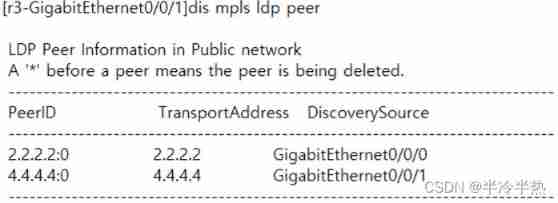
3. To configure MPLS-VPN
Connect R1 Interface
[r2]ip vpn-instance a Create a a Of vpn Space
[r2-vpn-instance-a]ipv4-family Get into IPV4 In configuration mode
[r2-vpn-instance-a-af-ipv4]route-distinguisher 1:1 RD value
[r2-vpn-instance-a-af-ipv4]vpn-target 1:1 RT value Must be end-to-end PE End consistent
[r2]int g 0/0/0 Go to the link CE The interface of the end
[r2-GigabitEthernet0/0/0]ip binding vpn-instance a Related to vpn Space
[r2-GigabitEthernet0/0/0]ip address 192.168.2.2 24 Configuration private ip Address
Connect R6 Interface :
[r2]ip vpn-instance b
[r2-vpn-instance-b]ipv4-family
[r2-vpn-instance-b-af-ipv4]route-distinguisher 2:2
[r2-vpn-instance-b-af-ipv4]vpn-target 2:2
[r2-vpn-instance-b-af-ipv4]q
[r2-vpn-instance-b]q
[r2]int g 0/0/1
[r2-GigabitEthernet0/0/2]ip binding vpn-instance b
[r2-GigabitEthernet0/0/2]ip address 192.168.2.2 24
Connect R5 Interface
[r4]ip vpn-instance a1
[r4-vpn-instance-a]ipv4-family
[r4-vpn-instance-a-af-ipv4]route-distinguisher 1:1
[r4-vpn-instance-a-af-ipv4]vpn-target 1:1
[r4-vpn-instance-a-af-ipv4]q
[r4-vpn-instance-a]q
[r4]int g 0/0/1
[r4-GigabitEthernet0/0/1]ip binding vpn-instance a1
[r4-GigabitEthernet0/0/1]ip add 192.168.3.1 24
Connect R7 Interface
[r4]ip vpn-instance b1
[r4-vpn-instance-b]ipv4-family
[r4-vpn-instance-b-af-ipv4]route-distinguisher 2:2
[r4-vpn-instance-b-af-ipv4]vpn-target 2:2
[r4-vpn-instance-b-af-ipv4]q
[r4-vpn-instance-b]q
[r4]interface g0/0/1
[r4-GigabitEthernet0/0/2]ip binding vpn-instance b1
[r4-GigabitEthernet0/0/2]ip address 192.168.3.1 24
4. To configure MP-BGP
[r2]bgp 1
[r2-bgp]router-id 2.2.2.2
[r2-bgp]peer 4.4.4.4 as-number 1
[r2-bgp]peer 4.4.4.4 connect-interface lo 0
[r2-bgp]ipv4-family vpnv4
[r2-bgp-af-vpnv4]peer 4.4.4.4 enable
[r4]bgp 1
[r4-bgp]route-select
[r4-bgp]router-id 4.4.4.4
[r4-bgp]peer 2.2.2.2 as-number 1
[r4-bgp]peer 2.2.2.2 connect-interface lo 0
[r4-bgp]ipv4-family vpnv4
[r4-bgp-af-vpnv4]peer 2.2.2.2 enable
5. Configure customer loopback and ip Address
[r1]int lo 0
[r1-LoopBack0]ip add 192.168.1.1 24
[r1-LoopBack0]int g 0/0/0
[r1-GigabitEthernet0/0/1]ip ad 192.168.2.1 24
[r6]int lo 0
[r6-LoopBack0]ip add 192.168.1.1 24
[r6-LoopBack0]int g0/0/0
[r6-GigabitEthernet0/0/1]ip add 192.168.2.1 24
[r5]int g0/0/0
[r5-GigabitEthernet0/0/0]ip add 192.168.3.2 24
[r5-GigabitEthernet0/0/0]int lo 0
[r5-LoopBack0]ip add 192.168.4.1 24
[r7]int lo 0
[r7-LoopBack0]ip add 192.168.4.2 24
[r7-LoopBack0]int g0/0/0
[r7-GigabitEthernet0/0/0]ip add 192.168.3.2 24
6. Configuration dynamics
[r6]rip 1
[r6-rip-1]version 2
[r6-rip-1]un summary
[r6-rip-1]network 192.168.1.0
[r6-rip-1]network 192.168.2.0
[r2]rip 1 vpn-instance b
[r2-rip-1]network 192.168.2.0
R2 Upper vrf Of b The spatial routing table can see that it has passed rip Learning to 192.168.1.0 route
[r7]ospf 1 router-id 7.7.7.7
[r7-ospf-1]area 0
[r7-ospf-1-area-0.0.0.0]network 192.168.3.2 0.0.0.0
[r7-ospf-1-area-0.0.0.0]network 192.168.4.2 0.0.0.0
[r4]ospf 2 vpn-instance b1 stay vrp Space b1 Start the ospf process 2
[r4-ospf-2]area 0
[r4-ospf-2-area-0.0.0.0]network 192.168.3.1 0.0.0.0
stay R4 Upper vpn Space b1 The routing table can see that it has passed ospf Learning to 192.168.4.2 route
7. Two way republication
[r2]rip 1 vpn-instance b
[r2-rip-1]import-route bgp ---- hold BGP Resend cloth in rip
[r2]bgp 1
[r2-bgp]ipv4-family vpn-instance b
[r2-bgp-b]import-route rip 1 --- hold rip Resend cloth in BGP
[r4]bgp 1
[r4-bgp]ipv4-family vpn-instance b1
[r4-bgp-b1]import-route ospf 2 --- hold ospf 2 Resend cloth in BGP
[r4]ospf 2 vpn-instance b1
[r4-ospf-2]import-route bgp ---- hold BGP Resend cloth in ospf 2
You can see in the R6 Learned from the routing table 3.0 and 4.2 route , stay R7 Learned from the routing table 1.1 and 2.0 route
stay R6 On can ping through R7 The loopback of
8. Configure static
[r1]ip route-static 192.168.3.0 24 192.168.2.2
[r1]ip route-static 192.168.4.0 24 192.168.2.2
[r2]ip route-static vpn-instance a 192.168.1.0 24 192.168.2.1
[r5]ip route-static 192.168.1.0 24 192.168.3.1
[r5]ip route-static 192.168.2.0 24 192.168.3.1
[r4]ip route-static vpn-instance a1 192.168.4.0 24 192.168.3.2
9. Republish static 、 Direct connection
[r2]bgp 1
[r2-bgp]ipv4-family vpnv4
[r2-bgp]ipv4-family vpn-instance a
[r2-bgp-b]import-route static
[r2-bgp-b]import-route direct
[r4]bgp 1
[r4-bgp]ipv4-family vpnv4
[r4-bgp]ipv4-family vpn-instance a1
[r4-bgp-b]import-route static
[r4-bgp-b]import-route direct
The experiment is finished
边栏推荐
- SQL:存储过程和触发器~笔记
- 美国科技行业结束黄金时代,芯片求售、裁员3万等哀声不断
- Replace Internet TV set-top box application through digital TV and broadband network
- guava:创建immutableXxx对象的3种方式
- Run the deep network on PI and Jetson nano, and the program is killed
- 【力扣刷题】32. 最长有效括号
- Fzu 1686 dragon mystery repeated coverage
- 缓存更新策略概览(Caching Strategies Overview)
- Is it profitable to host an Olympic Games?
- Proxy and reverse proxy
猜你喜欢
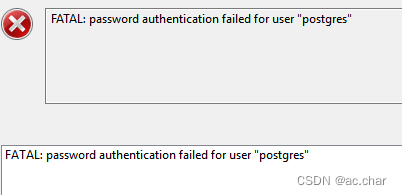
PostgreSQL 修改数据库用户的密码

快讯:飞书玩家大会线上举行;微信支付推出“教培服务工具箱”

缓存更新策略概览(Caching Strategies Overview)
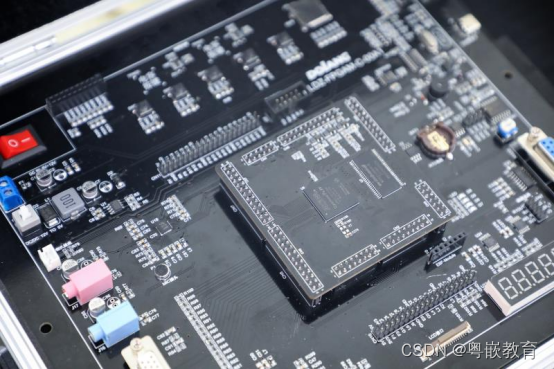
Seven original sins of embedded development

红杉中国,刚刚募资90亿美元
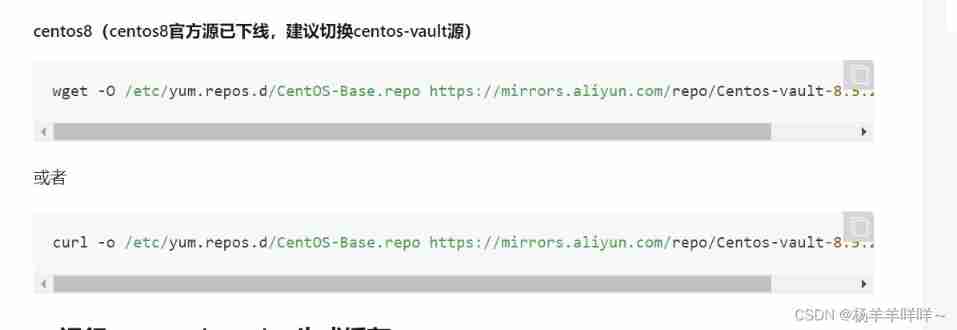
Set up a time server

JS method to stop foreach
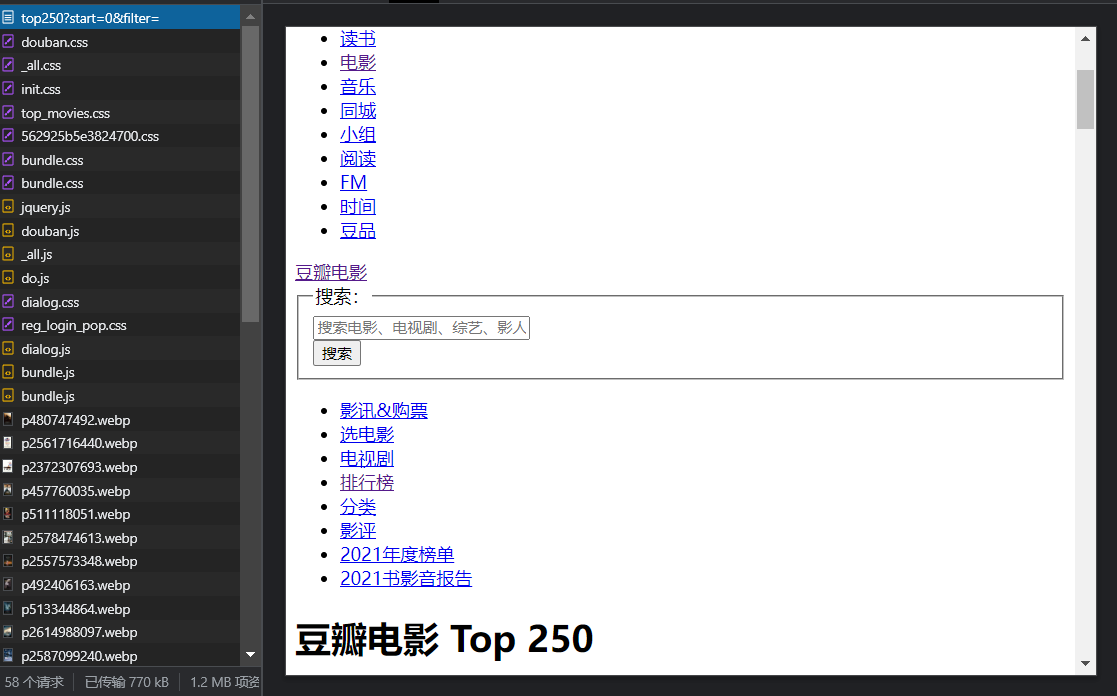
Reptile practice (V): climbing watercress top250
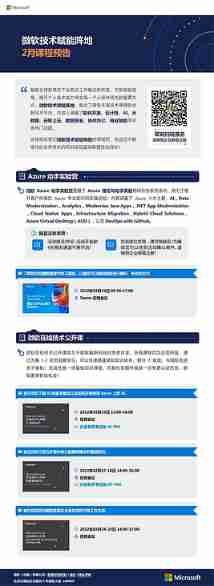
Microsoft technology empowerment position - February course Preview

Internet News: Geely officially acquired Meizu; Intensive insulin purchase was fully implemented in 31 provinces
随机推荐
在最长的距离二叉树结点
Forward maximum matching method
【Redis设计与实现】第一部分 :Redis数据结构和对象 总结
抖音將推獨立種草App“可頌”,字節忘不掉小紅書?
Absolute primes (C language)
嵌入式开发的7大原罪
50个常用的Numpy函数解释,参数和使用示例
Tips for web development: skillfully use ThreadLocal to avoid layer by layer value transmission
JPEG2000 matlab source code implementation
JS method to stop foreach
代理和反向代理
Digital transformation takes the lead to resume production and work, and online and offline full integration rebuilds business logic
guava:Collections.unmodifiableXXX创建的collection并不immutable
互联网快讯:吉利正式收购魅族;胰岛素集采在31省全面落地
@Detailed differences among getmapping, @postmapping and @requestmapping, with actual combat code (all)
In JS, string and array are converted to each other (I) -- the method of converting string into array
Uni app app half screen continuous code scanning
Nodejs教程之Expressjs一篇文章快速入门
C language char, wchar_ t, char16_ t, char32_ Relationship between T and character set
Why is the cluster mode of spark on Yan better than the client mode